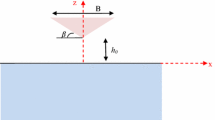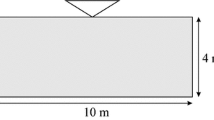Abstract
The effects of hydrophobicity on free surface elevation and impact loads are experimentally investigated during the water entry of wedges and cones with various deadrise angles, with particular attention given to the early stages of the impact. As opposed to spheres and cylinders, there is no Froude number dependency and hydrophobicity is not associated only with cavity formation, since a cavity is created at any velocity and at any contact angle in case of wedges and cones. It is observed that the formation of the jet flow, pileups and cavities during the water entry of the objects with constant deadrise angles are modified under the hydrophobic effects. There is no flow separation and the jet root travels faster along the solid surface and larger pileups with larger wetting factors change the chine wetting time resulting in smaller magnitudes when hydrophobicity is present. The slamming coefficient values under hydrophobic effects are measured about 10–25% smaller than the ones obtained with hydrophilic surfaces. Hydrophobic effects are stronger at smaller deadrise angles. It is also shown that the wetted length depends not only on the geometry but also the solid surface characteristics, and the amount of added mass is not proportional to the wetted area and may be decreased with increased wetted width depending on the contact angle.
Graphic abstract















Similar content being viewed by others
References
Aristoff JM, Truscott TT, Techet AH, Bush JWM (2010) The water entry of decelerating spheres. Phys Fluids 22:032102
Battistin D, Iafrati A (2003) Hydrodynamic loads during water entry of two-dimensional and axisymmetric bodies. J Fluids Struct 17(5):643–664
Bereznitski A (2001) Slamming: the role of hydroelasticity. Int Shipbuilding Progress 48(4):333–351
Clanet C, Beguin C, Richard D, Quere D (2004) Maximal deformation of an impacting drop. J Fluid Mech 517:199–208
Cointe R, Armand JL (1987) Hydrodynamic impact analysis of a cylinder. J Off Mech Arctic Eng 109(3):237–243
Cointe R, Fontaine E, Molin B, Scolan YM (2004) On energy arguments applied to the hydrodynamic impact force. J Eng Math 48(3–4):305–319
De Backer G, Vantorre M, Beels C, De Pre J, Victor V, De Rouck J, Blommaert C, Van Paepegem W (2009) Experimental investigation of water impact on axisymmetric bodies. App Ocean Res 31(3):143–156
Duclaux V, Caille F, Duez C, Ybert C, Bocquet L, Clanet C (2007) Dynamics of transient cavities. J Fluid Mech 591:1–19
Duez C, Ybert C, Clanet C, Bocquet L (2007) Making a splash with water repellency. Nat Phys 3:180–183
Faltinsen OM, Zhao R (1997) Water entry of ship sections and axisymmetric bodies. in AGARD FDP and Ukraine Inst. of Hydromech. workshop on high speed body motion in water 24, 11.
He B, Patankar A, Lee J (2003) Multiple equilibrium droplet shapes and design criterions for rough hydrophobic surfaces. Langmuir 19:4999–5003
Korkmaz FC, Guzel B (2017) Water entry of cylinders and spheres under hydrophobic effects; case for advancing deadrise angles. Ocean Eng 129(1):240–252
Korobkin A, Guéret R, Malenica Š (2006) Hydroelastic coupling of beam finite element model with Wagner theory of water impact. J Fluids Struct 22(4):493–504
Lee DG, Kim HY (2008) Impact of a superhydrophobic sphere onto water. Langmuir 24:142–145
Mei XM, Liu YM, Dick KP (1999) On the water impact of general two-dimensional sections. App Oc Res 21:1–15
Marston JO, Thoroddsen ST (2014) Ejecta evolution during cone impact. J Fluid Mech 752:410–438
Panciroli R, Porfiri M (2013) Evaluation of the pressure field on a rigid body entering a quiescent fluid through particle image velocimetry. Exp Fluids 54(12):1630
Panciroli R, Ubertini S, Minak G, Jannelli E (2015) Experiments on the dynamics of flexible cylindrical shells impacting on a water surface. Exp Mech 55:1537–1550
Shentu J, Zhao T, Li D, Zhao X (2019) Numerical simulations for water entry of hydrophobic objects. Ocean Eng 190:106485
Speirs N, Mansoor M, Belden J, Truscott T (2019) Water entry of spheres with various contact angles. J Fluid Mech 862:R3
Tenzer M, Moctar OE, Schellin T (2015) Experimental investigation of impact loads during water entry. Ship Technol Res 62(1):47–59
Truscott TT, Epps BP, Techet A (2012) Unsteady forces on spheres during free-surface water entry. J Fluid Mech 704:173–210
Von Kármàn T (1929) The impact on seaplane floats during landing. National Advisory Committee for Aeronautics. Tech note No 321:309–313
Vorus WS (1996) Flat cylinder theory for vessel impact and steady planing resistance. J Shp Res 40(2):89–106
Wagner H (1932) Uber stoss und Gleitvorgänge an der Oberfläche von Flüssigkeiten. Zeitschrift fur Angewandte Mathematik und Mechanik 12:193–215
Wang Z, Lopez C, Hirsa A, Koratkar N (2007) Impact dynamics and rebound of water droplets on superhydrophobic carbon nanotube arrays. Appl Phys Lett 91:023105
Weymouth GD, Yue DKP (2011) Boundary data immersion method for Cartesian-grid simulations of fluid-body interaction problems. J Comput Phys 230:6233–6247
Yettou EM, Desrochers A, Champoux Y (2007) A new analytical model for pressure estimation of symmetrical water impact of a rigid wedge at variable velocities. J Fluids Struct 23(3):501–522
Zhao R, Faltinsen OM (1993) Water Entry of Two-Dimensional Bodies. J Fluid Mech 246:593–612
Zhao R, Faltinsen O, Aarsnes J (1996) Water entry of arbitrary two-dimensional sections with and without flow separation. In: Proceedings of the 21st symposium on naval hydrodynamics. National Academy Press, Washington DC, pp 408–423
Author information
Authors and Affiliations
Corresponding author
Additional information
Publisher's Note
Springer Nature remains neutral with regard to jurisdictional claims in published maps and institutional affiliations.
Rights and permissions
About this article
Cite this article
Güzel, B., Korkmaz, F.C. Experimental investigation of water entry of bodies with constant deadrise angles under hydrophobic effects. Exp Fluids 62, 107 (2021). https://doi.org/10.1007/s00348-021-03202-x
Received:
Revised:
Accepted:
Published:
DOI: https://doi.org/10.1007/s00348-021-03202-x




